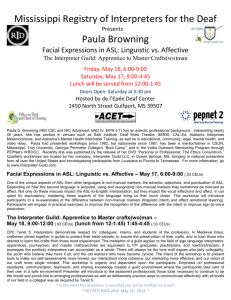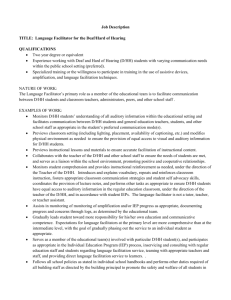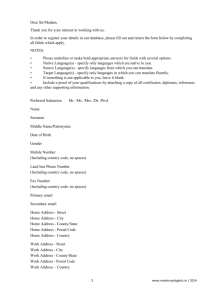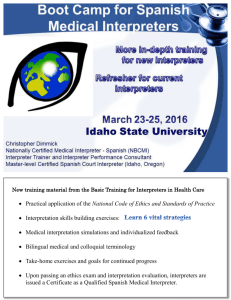Interpreting language contact, gender variation and generational
advertisement
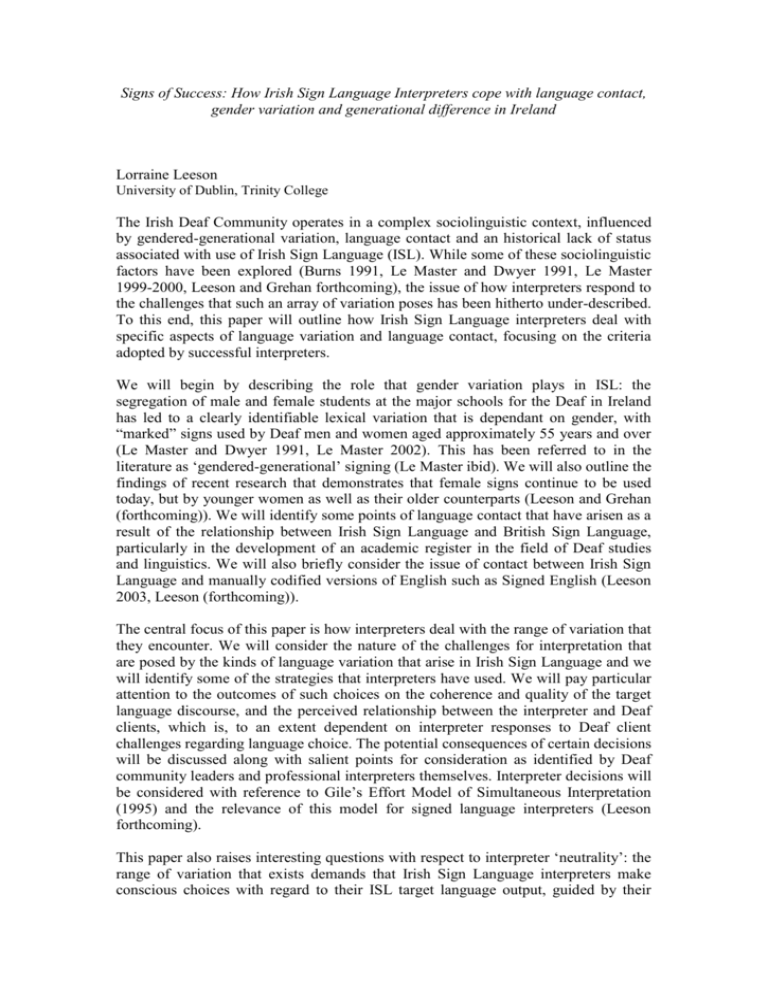
Signs of Success: How Irish Sign Language Interpreters cope with language contact, gender variation and generational difference in Ireland Lorraine Leeson University of Dublin, Trinity College The Irish Deaf Community operates in a complex sociolinguistic context, influenced by gendered-generational variation, language contact and an historical lack of status associated with use of Irish Sign Language (ISL). While some of these sociolinguistic factors have been explored (Burns 1991, Le Master and Dwyer 1991, Le Master 1999-2000, Leeson and Grehan forthcoming), the issue of how interpreters respond to the challenges that such an array of variation poses has been hitherto under-described. To this end, this paper will outline how Irish Sign Language interpreters deal with specific aspects of language variation and language contact, focusing on the criteria adopted by successful interpreters. We will begin by describing the role that gender variation plays in ISL: the segregation of male and female students at the major schools for the Deaf in Ireland has led to a clearly identifiable lexical variation that is dependant on gender, with “marked” signs used by Deaf men and women aged approximately 55 years and over (Le Master and Dwyer 1991, Le Master 2002). This has been referred to in the literature as ‘gendered-generational’ signing (Le Master ibid). We will also outline the findings of recent research that demonstrates that female signs continue to be used today, but by younger women as well as their older counterparts (Leeson and Grehan (forthcoming)). We will identify some points of language contact that have arisen as a result of the relationship between Irish Sign Language and British Sign Language, particularly in the development of an academic register in the field of Deaf studies and linguistics. We will also briefly consider the issue of contact between Irish Sign Language and manually codified versions of English such as Signed English (Leeson 2003, Leeson (forthcoming)). The central focus of this paper is how interpreters deal with the range of variation that they encounter. We will consider the nature of the challenges for interpretation that are posed by the kinds of language variation that arise in Irish Sign Language and we will identify some of the strategies that interpreters have used. We will pay particular attention to the outcomes of such choices on the coherence and quality of the target language discourse, and the perceived relationship between the interpreter and Deaf clients, which is, to an extent dependent on interpreter responses to Deaf client challenges regarding language choice. The potential consequences of certain decisions will be discussed along with salient points for consideration as identified by Deaf community leaders and professional interpreters themselves. Interpreter decisions will be considered with reference to Gile’s Effort Model of Simultaneous Interpretation (1995) and the relevance of this model for signed language interpreters (Leeson forthcoming). This paper also raises interesting questions with respect to interpreter ‘neutrality’: the range of variation that exists demands that Irish Sign Language interpreters make conscious choices with regard to their ISL target language output, guided by their knowledge of the Deaf clients attending an event and the context in which they are interpreting. Such choices can have consequences for the kinds of inferences that a target language audience makes about the source language presenter/s.1 While interpreters can and do get it wrong, this paper above all focuses on what it is that interpreters do to successfully deal with the challenges that sociolinguistic variation poses, considering authentic data to demonstrate the strategies that are utilised, and identifying underlying principles that guide successful interpreters in their work. References Burns, S. 1991: The Sociolinguistic Status of Irish Sign Language: An Observational Study. Unpublished Dissertation. Centre for Language and Communication Studies (CLCS), University of Dublin, Trinity College. Gile, D. 1995: Basic Concepts and Models for Interpreter and Translator Training. Amsterdam and Philadelphia. John Benjamins. Leeson, L. 2003: Sign Language Interpreters: Agents of Social Change in Ireland? An exploration of the relationships between the Deaf Community and Irish Sign Language Interpreters. In M. Cronin and C. Ó’ Cuilleanáin (eds.) The Languages of Ireland. Dublin: Four Courts Press. Leeson, L (forthcoming) Making the Effort in Simultaneous Interpreting– Some Considerations for Signed Language Interpreters. In Janzen, T. (ed.) ‘Fundamentals of Signed Language Interpretation: Theory and Practice’ John Benjamins Leeson, L. and Grehan, C. (forthcoming): To the Lexicon and Beyond: Gender as a Variable Affecting Variation in Irish Sign Language. In Van Herreweghe, M. and Veermerbergen, M. (eds.): The Sociolinguistics of European Sign Languages. Washington DC: Gallaudet University Press. Le Master, B. 1990: The Maintenance and Loss of Female and Male Signs in the Dublin Deaf Community. Unpublished doctoral dissertation. UCLA. Le Master, B. 1999-2000: Reappropriation of Gendered Irish Sign Language in One Family. Visual Anthropology Review. Volume 15: 2. Fall-Winter 1999-2000. 1-15. Le Master, B. and Dwyer, J.P. 1991: Knowing and Using Female and Male Signs in Dublin. Sign Language Studies 73, 361-396. 1 An example of this occurred where an interpreter was working in Dublin, interpreting from British Sign Language to English at an event that involved Irish, Northern Irish and British participants, Deaf and hearing. While a British Deaf presenter referred to the UK using an INDEX towards a locus to the right, the interpreter interpreted this as ‘over on the mainland’. While accurate, this was politically loaded in an Irish context as it implied that the Republic, a former British colony, was somehow still tied to the UK. The target language also added implied political undertones that simply were not present in the original message. The implications were picked up on by the audience, which literally gasped. Here, the very highly skilled interpreter was not technically ‘incorrect’, but the implications of their choice was motivated by the variation that exists in English as used in Northern Ireland, and this was pragmatically marked when used in the Republic. While this paper will focus on variation in ISL, the underlying premises remain significant: how interpreters deal with variation has serious implications.


